The Evolution of Hairstyles in ancient time
Hairstyles refer to the art of arranging hair according to fashion or personal taste. This can be studied through three main aspects:
- The arrangement of hair, commonly referred to as the hairstyle itself.
- Decorative or functional hair ornaments.
- Headwear, which may complement or interact with the hairstyle.
Cultural influences and racial characteristics significantly shape hairstyles, while natural environments play a minimal role.
Prehistoric Times
As early as prehistoric times, humans valued hair adornment. Notable examples from the Paleolithic era include figures such as the Lady of Amiens found at Renancourt, discovered at Renancourt near Amiens in northern France (23,000 years ago), the Venus of Willendorf in Austria (23,000–19,000 BCE), and the Lady of Brassempouy in France (27,000 years), also known as Dame à la Capuche. These figures display women with intricately styled hair.
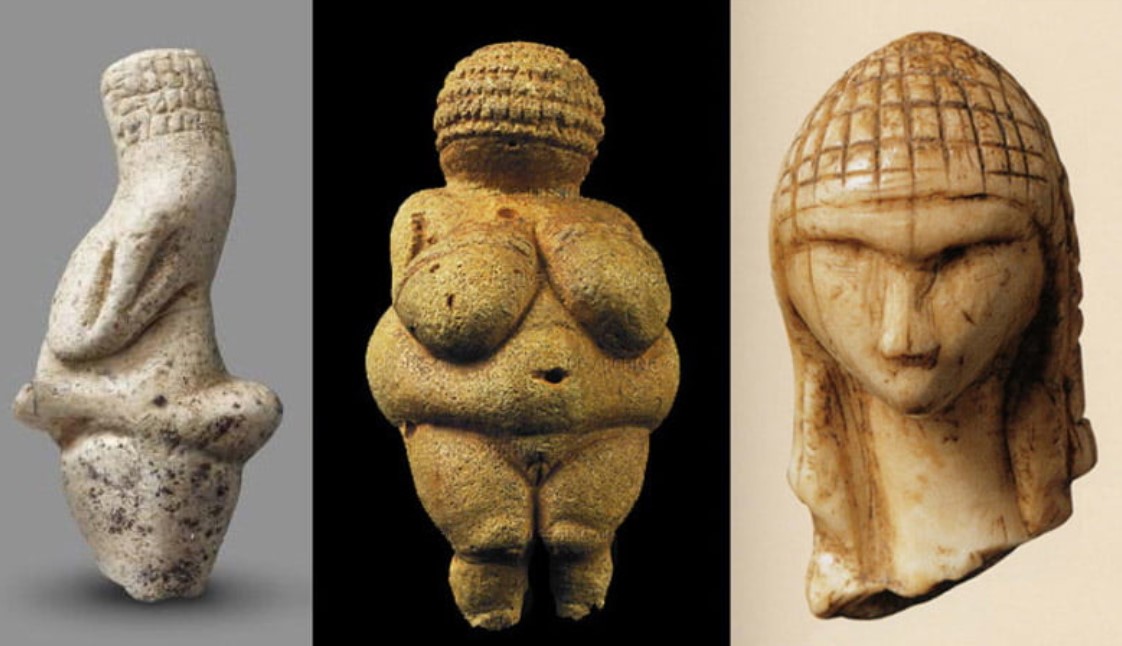
The Lady of Amiens, the Lady of Willendorf, and the Lady of Brassempouy.
In contrast, burials of contemporaneous individuals such as Woman of di Paglicci, Woman of Caviglione, Woman of Ostuni and the Prince of Arene Candide, all found in Italy, revealed mollusk-based head coverings. Intriguingly, similar practices have been observed as far as 3,000 kilometers away in Sungir, Russia.

Reconstruction of the face of the woman of the Caviglione from the Gravettian era (24,000 years ago) - Grotte Balzi Rossi, Italy.
The Woman of Caviglione is particularly noteworthy. Her burial, discovered in 1872, was adorned with a cap made of shells and deer teeth, a bracelet around her leg, and a set of horse bones. Initially believed to be male due to her tall stature (about 190 cm), she was dubbed the Man of Mentone. However, DNA testing in 2016 confirmed her sex. Scientific studies also revealed she had given birth, lived to an advanced age for the time (about 37 years), and bore signs of a defensive wound.

Egyptian lute players women with braided hair and ornamental headdress. Fresco found in Thebes, from the tomb of Nebamun, a nobleman in the 18th Dynasty of Ancient Egypt (c. 1350 BCE)
Ancient Egyptian Hairstyles
In the times of the ancient Egyptians, there was a custom to shave your head and cover it with voluminous wigs. They differentiate the male gender from the female but also the social status. Especially among the people they could not be spread because their cost of production and maintenance were not indifferent.
In the lower and middle classes, Egyptians shaved their heads completely or styled their natural hair.

Model of a procession of offering bearers, reign of Amenemhat I, early. Plastered and painted wood, linen - Metropolitan Museum of Art, New York, USA
In the higher classes:
- Men:
Wealthy men wore long hair styled in various ways. They often used wigs made from materials such as horsehair, wool, or palm fiber, depending on their social status. Additionally, they wore a rectangular cloth called a klaft, often colored with red stripes, fixed on the head with a metal circle, and fell softly to the sides of the face. While early Egyptian men were clean-shaven, pharaohs occasionally donned stylized false beards as a divine symbol. Later, possibly influenced by Semitic traditions, men began growing natural beards. - Women:
Women typically shaved their heads or kept their hair short, covering it with one or more intricately curled and braided wigs. These wigs were decorated with flowers, colored ribbons, and metal bands. - Pharaohs and deities wore elaborate headdresses, such as the pschent or atew, often adorned with gold and a prominent snake emblem, symbolizing royalty and divinity.

In tomb N.45, in the lower cemetery of Thebes, a statuette 19 cm high, from 18 was found. The figure represents the barber Meryma'at, responsible for shaving the priests of the Temple of Amon. It was a ritual performed every three days, and consisted of shaving their entire body, including their face and head. This small statue shows the importance that barbers had in the temple of Amun, and the high standing of their social position.

Merit’s wig. An exceptional artifact that belonged to Merit is her wig, made with real locks of hair that were sewn together and braided. The hair is parted in the middle and curled into ringlets that end with braids on either side of the face and on the back of the neck. This type of hairdo was often decorated with flowers and diadems, which were very fashionable in the mid-18th dynasty, as can be seen in the paintings and statues of the period. - The Egyptian Museum in Turin, Italy.
[ca. 500 BCE] The priests of the gods in other lands wear long hair, but in Egypt they shave their heads: among other men the custom is that in mourning those whom the matter concerns most nearly have their hair cut short, but the Egyptians, when deaths occur, let their hair grow long, both that on the head and that on the chin, having before been close shaven … (Herodotus, Histories, 2.36 - ca. 430 BCE)

Detail of the Sarcophagus of Queen Kawit, Wife of MENTUHOTEP II.- Egyptian Museum Cairo. The queen is depicted with short hair, she is sitting on a chair, a servant girl is arranging her hair, while a servant is pouring her a drink.
And when all his preparations had been completed Osiris made a vow to the gods that he would let his hair grow until his return to Egypt and then made his way through Ethiopia; and this is the reason why this custom with regard to their hair was observed among the Egyptians until recent times, and why those who journeyed abroad let their hair grow until their return home (Diodorus Siculus, Library 1-7, 1.18.1 - ca. 49 BCE)
In Mesopotamia, far to the east of Egypt, hairstyles reflected social status and cultural influences.
Sumerians
The Agyges ('black head', presumably because of their hair color), were called Sumerians by their successors, the Akkadians.
Sumerians men shaved their faces like the Egyptians, contrasting with the Semitic inhabitants who wore beards.

"The Standard of Ur", from Royal Cemetery (Ur, Iraq), Early Dynastic III - The British Museum, London
It is decorated with inlaid mosaic scenes made from shell, red limestone and lapis lazuli, set in bitumen.In this scene of banquet, the men are entertained at the right by a singer and a man playing a lyre.
Women styled their long hair into elaborate buns (a band that was like a turban around the head), or tiaras (solid gold, silver or stones) adorned with gold powders and combs. The queens wore a wide veil, the aristocrats wore a large wig and a tall hard headdress from which the hair came out, falling to broad strands on the shoulders.

Bust of a female votive statuette (2,600-2,350 BC) - Princeton University Art Museum.
It represents a woman during the act of prayer, one of the most represented themes in the Sumerian statuary. This prayerful woman wears a very elaborate hairstyle, with two-part hair, two kinds of braids that frame the face and a tiara or a headband on top of the head. The back of the figurine shows the complexity of the hairstyle.

Lady of Lagash, chlorite, circa 2,120 BCE, Tello, Louvre Museum, Paris.
The statue is an example of how hairstyles change with the invasion of the Gutei. She has slightly wavy hair, divided by a central stripe and gathered in a soft bun on the nape.
After the second millennium BCE, under the influence of the Semitic Achaedii, the women brought cones with aromatic essences inside the hair to keep it fragrant all day; while in the Babylonian period they started to use henna (hair dye, substance extracted from the plant Lawsonia Inermis, dried and ground had a red or reddish-brown color). Henna also had magical (to scare evil spirits) and pharmacological (for the treatment of fungi) properties.

Mona Lisa of Nimrud, 720 BC - Iraqi National Museum in Baghdad
It is one of the rare iconographic testimonies of female hairstyles that came to us from Mesopotamia. Under a sort of crown, his hair is divided in the middle into two smooth bands that leave his ears uncovered.
The men began to wear their beard cut square and curled vertically, while their hair curled horizontally.
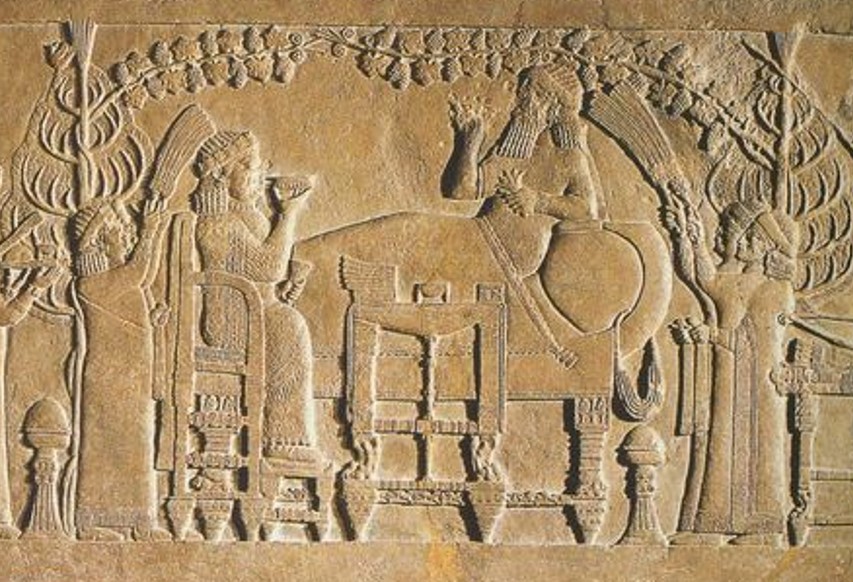
A relief from the Palace of Ashurbanipal, The king and his queen feasting in the royal gardens following the defeat and death of the Elamite King Teumman at the battle of Til Tuba in 653. Detail of king and queen. Assyrian. Late Assyrian, c 645 BCE. Nineveh, Assyria, Ancient Iraq.
Assyrian Hairstyles
Men used to create complicated hairstyles, dividing the hair on the forehead and letting it fall behind the ears with various levels of curls, with gold and silver threads. While women of the lower classes had long, loose hair or gathered in a bandage on the nape of the neck,while those of the upper classes picked up their hair in braids ending in curls.
[ca. 100 CE] To his friend Liber: Liber, dearest object of care to all your friends; Liber, worthy to live in ever-blooming roses; if you are wise, let your hair ever glisten with Assyrian balsam, and let garlands of flowers surround your head; let your pure crystal cups be darkened with old Falernian, and your soft couch be warm with the caresses of love (Martial, Epigrams, 8.77 - ca. 100 CE )
Hittite Hairstyles
In the oldest figurations, the hairstyle of the Hittites appears as a meticulous curling. Later on, the regular undulation is also found in women’s hairstyles, as well as the artificially parallel curls under the ribbon fronts. Characteristic of men is the upper lip, while the beard, pointed, is long.

The Inandik vase, also known as a Hüseyindede vase, a large, four-handled Hittite terracotta vase with music and dance at a sacred wedding ceremony, period of the Old Hittite Kingdom; about 1600 BCE - Museum of Anatolian Civilizations, Ankara, Turkey
Phoenician Hairstyles
It seems that the Phoenicians took inspiration for their hairstyles from the Egyptians and Assyrians. The men wore long curly hair and mitria. Women usually gathered their hair towards the top of their heads, and those of the upper classes created rich and complicated hairstyles.
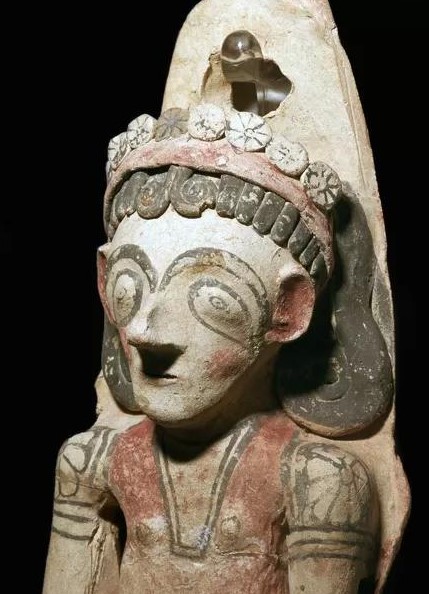
Phoenician statuette of a votary, 7th century BCE

Terracotta Sculpture of a Phoenician Women Cadiz Museum, Spain
Jewish Hairstyles
For a long time the Jewish men wore long hair, then this habit was reserved only to the young; later they used to cover their heads permanently with a piece of cloth turned several times around the head, and adopted various types of hairstyles.
The beard was worn full, and the religious law forbade to cut it on the cheeks (Leviticus, XIX, 27, XXI, 5), perhaps because such an act had taken on the character of sacrifice among the idolatrous Semiti. To cut off one’s beard (as on the other hand to shave one’s head) was a sign of mourning (Jeremiah, XLI, 5), and to cut it off to others constituted supreme injure: such an affront, made by the king of the Ammonites to the ambassadors of David, resulted in war (II King -Samuel-, X, 4), and it is threatened by God to Israel, in the prophetic books, as a sign of the ignominy into which the rebellious people will fall to divine commands (Isaiah, VII, 20, XV, 2; Jeremiah, XLVIII, 37; Micah, I, 16).
Totally different hairstyles of the Jewish women, in fact after the liberation from slavery, Moses forbade them to wear hair like the Egyptian women, and so they focused on naturalness and simplicity.

Reproduction of ancient Hebrews traveling into Egypt painted parietal from the tomb of Khumhotep III at Beni Hassan (Middle Kingdom)
Greek Hairstyles
In Greece, the hairstyles have undergone a continuous evolution. Their history is divided into two periods, that is before and after the wars with the Persians.

The frescoes of the palaces of Knossos and Phaistos depicted elegant hairstyles of Cretan women and men. Both showed curly hair, braided and then pinned to the nape with ribbons and beads, or left loose on the shoulders. In the upper right we see Minoan ladies with curls and locks of hair held by ribbons: fresco of the palace of Knossos.
Archaic period
In the Archaic period, long hair was a privilege reserved for the upper classes. Male and female hairstyles were quite similar, typically featuring short, regular curls on the forehead, while the hair at the nape of the neck was long and drooping. Hair was often styled in waves and curled artificially using gold or metal spirals, held in place by ribbons, bands, or wreaths of leaves. The hair was long at the back and sides, while the forehead displayed small, flat, and uniform curls. Frequently, hair was secured within a ribbon encircling the head.
According to Xenophon, Lycurgus mandated that teenage boys grow their hair long, while women were required to shave their heads. Helots also had their heads shaved. By the 5th century BCE, hairstyles changed significantly. Hair was cut short; it remained long during childhood but was cut at puberty and dedicated to deities such as Artemis and Apollo. Young men wore short curls, while older men allowed slightly longer hair.
Hairstyles varied by social class. An elegant style called the "garden" hairstyle consisted of short hair curled around the head. Women often tied their hair into a bow on top of their head, sometimes allowing it to fall naturally over their shoulders, held in place by ribbons, nets, or handkerchiefs. Among men, beards, goatees, and mustaches were common.

Some faces of the Greek sculpture: first line archaic age (VIII-VI c. BCE); second line classical age (480-323 BCE); third line hellenistic age (323-31 BCE). Archaic faces are simplified, symmetrical, not very expressive and often show a slight smile (called, in fact, archaic). The classic faces are more proportionate and have an indifferent or severe expression. The Hellenistic faces are much more expressive: they can be in pain, frightened or even asleep.
In the upper left we observe the statue of a young man with 'pearl hairstyle' (hair falling on his back with strands separated by ribbons): marble statue (c. 600 BCE) - New York, Metropolitan Museum of Art.
Classical and Hellenistic periods
In these eras, women adorned their hair with ribbons, bandages, and tiaras, arranging it in curly styles or woven onto their shoulders. A popular style involved parting the hair in the middle, softly raising it over the temples, and knotting it simply at the nape, often with a ribbon or crocchia for support.
Key components of hairstyles included:
- Ampyx: A combination of gold bands and metallic strips, often adorned with precious stones, encircling the head.
- Kekryphalos: A cloth or bag cap enclosing the hair.
- Korymbos: A high knot of hair on the forehead, tied with a ribbon.
- Crobylus: Various styles featuring a tuft at the nape or top of the head, or two braids separated by a middle part.
- Tutulus: A conical, braided style resembling the ancient cap of the same name.
- Crown and Diadem: Made of gold or metal, these were worn by women of high status or statues of goddesses.
Greek women often dyed their hair black, shimmering blue, or blonde, sometimes using metallic powders.
Men typically kept their hair short and curly, with a style known as "garden." This use is so general that shaving seemed a ridiculous effeminacy. The Spartans required the cowards, as a sign of their cowardice, to grow a beard on one cheek (Plut., Ages., 30).
The custom of shaving your face was introduced by Alexander the Great. There were naturally exceptions, for example, were bearded elders and philosophers. This eccentricity of the philosophers found imitators also in later ages, especially among the cynics and stoics; and the philosopher’s beard became proverbial even among us.
The male hairstyle often in young people was made with a knot of hair high on the forehead (krobylos), sometimes tightened by a ribbon, as you can see in the images of Apollo. Later the most common hairstyle for men is short and curly, called "garden". In Mycenaean culture, short hair was sometimes adorned with a turban or peplum.

Apollo with hair knot on the forehead (krobylos). Bronze, Greek artwork, ca. 460 BC. Found in 1836 in Tamassos, Cyprus.

Hairstyle with pigtail and strands kept by the kekr yphalos, statue in marble (5th century BCE) from Taranto - Berlin, Sraatliche Museen
Etruscan Hairstyles
Etruscan hairstyles were initially similar to Greek orientalizing styles. Men had meticulously combed long hair, falling in curls over the shoulders and framing the face with rows of small curls on the forehead. Women wore long side curls or braids, sometimes reaching the ground, or collected their hair in intricate braids at the nape. .

The Tomb of the Leopards fresco, c.480-450 BCE - Etruscan necropolis of Monterozzi, Tarquinia.
By the 5th century BCE, influenced by Greek art, Etruscan men adopted shorter hairstyles, and symmetry was abandoned. Women, while retaining side curls, began gathering their hair at the nape with a small cecriphalus, a kind of cap purely Greek.

Tomb of the Two Roofs (Tomba dei Due Tetti), 1st Half of the 2nd Century BCE - Monterozzi necropolis, Tarquinia, Viterbo, Lazio, Italy
The fresco depicts the dead man buried below, with a child and a demon carrying a torch, arriving at the door to Hades, received by two dead family members. Note as all men's hair are shortened.
This tomb contains tombs carved into benches and belonged to the Arnthunas family. The necropolis was founded in the 7th century BC and contains around 6000 graves, many of which are covered in frescos. Monterozzi is listed as a UNESCO World Heritage Site.
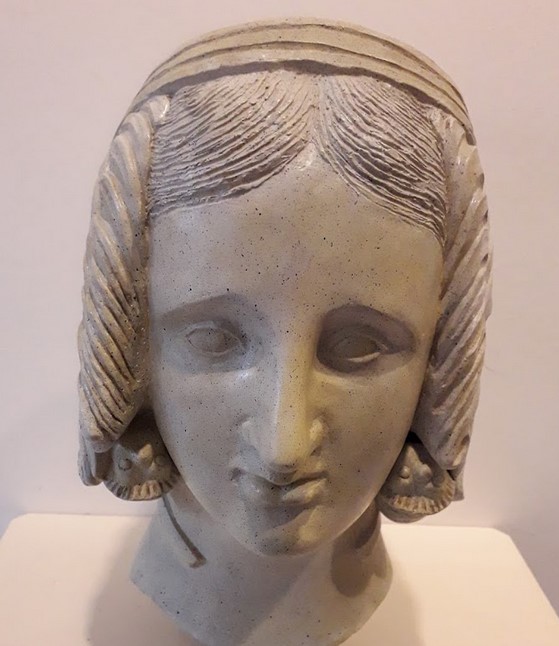
Head of a young woman. Wearing a circlet, torque, and spiral earrings with lion protomes. Terracotta, 2nd half of the 4th c. BCE. From the votive deposit in the sanctuary of Minerva Tritonia, Lavinium - Museo Archeologico Lavinium, Pomezia (RM), Italy
Roman Hairstyles
Early Romans wore long hair and beards. However according to Varrone, by the 3rd century BCE, the first barbers was brought to Rome and among the Italic from Sicily (Magna Graecia) by Publius Ticinius Menea, and since then Greek styles influenced Roman fashion. Long hair was abandoned, and the face was shaved. Only in the last days of the Republic do the elegant ones curl by tonsor, use this one that does not decays anymore for several centuries.
Scipio Africano was the first to start shaving every day, according to a news transmitted by Pliny (Nat. Hist., VII, 211), which should be received with reservations, taking into account the tendency of tradition to make Scipio the initiator of all Greek import refinements.
With the emperor Hadrian, forced to wear a long beard to hide facial defects, stopped the fashion of shaving, but for a short time: from the age of Constantine onwards it was returned to the use of before.
As with other peoples, to grow a long uncultivated beard was a sign of mourning (barbam promittere, demittere, submittere) or even a means of showing pity to the judges, before whom the accused presented themselves dirty and badly in gear (sorditati).

A tonsor found in Pompeii, dated to the beginning of first century CE.
The richest had tonsors among the slaves. The less well-off went to the shops of tonsor, so crowded that they became salons. The first cut of the beard was the ceremony of depositio barbae (laying the beard), for a Roman marked the passage from adolescence to maturity of youth. The ritual took different forms depending on the individual case. As a rule, the young man would grow his first hair until it looked like a real beard. Then it was time to cut it. Usually the depositio took place around the age of 21. The vel lanugo (first beard) was placed in a pisside made of gold for the richer or less valuable materials for the less well off. The first beard was offered to a god or ancestor. In general until age of 40, one continued to carry a beard (barbula). That is why the Romans associated with the beard the idea of youth.
Similarly, the matrons used the services of ornatrices to style their hair, always in order to highlight their social status.

Female portrait of Flavia age (69-96 CE) so called 'Busto Fonseca' - Musei Capitolini, Rome
The hair is braided with back crotch and toupet with bouquet of curls
According to the testimonies of Plautus and Tertullian, Roman women when they were married, divided with the needle in six strands or braids their hair then raising it up and supporting it with bandages that were, according to Servius, purple color, Whereas the virgins had only narrow white ribbons. Ovid complains that women, using the red-hot tinctures and needles to curl their hair, end up losing it.
In imperial Rome the patricians did not personally wait for their hairstyle, but at that office they employed educated slaves, called ornatrices, distinguished from the cosmetes, generally assigned to their toilet. The helpers of ornatrices were slaves of lower rank called ciniflones or cinerari.
From the Greeks, the Romans took the use, especially during banquets, to adorn their heads with garlands of roses or gillyflowers, sometimes mixed with twigs of myrtle. A crown of roses woven with myrtle was placed on the head of the brides on the day of their wedding.
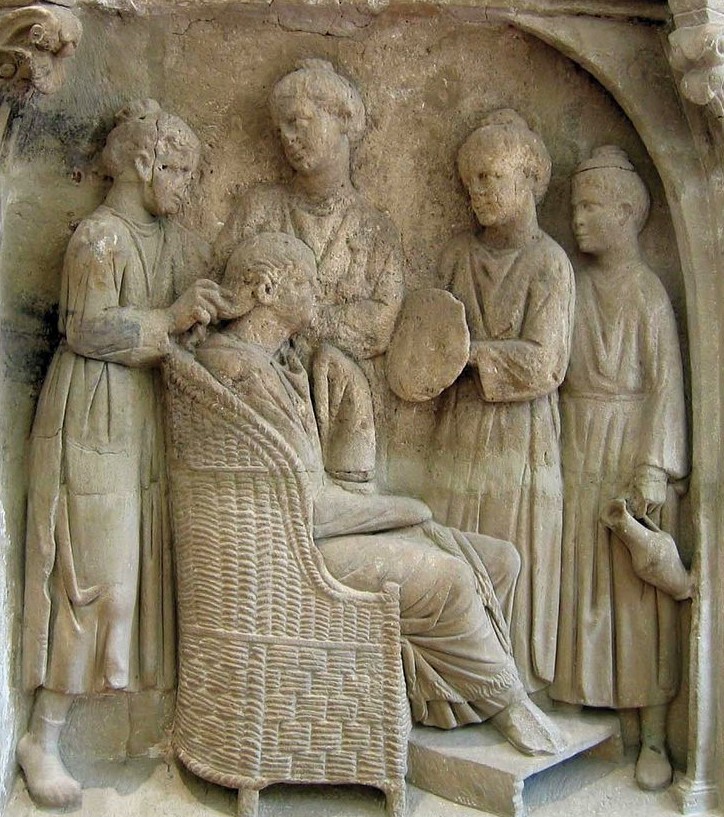
Funerary relief from Neumagen depicting a woman's hair being dressed by her slaves, circa 220 AD, Rheinisches Landesmuseum Trier, Germany. (Left) matron at her morning toilet; (right) shopkeepers or ornatrix, c. 220 CE - Treviri, Rheinisches LandesMuseum
The relief shows a matron attended by four female servants during her morning toilette: two of them take care of her hair while the third one holds a round mirror and the fourth one brings a jug of water. The matron sits in an elaborate wicker armchair, so the relief provides additional evidence of the use of this piece of furniture in Roman Trier.
Barbarians had different hairstyles, but almost always characterized by long hair. The Celts, who imbibed their hair with lime water, also wore them long; one of the three lines of the cocks was said to be this from the Romans comata (long-haired, having long hair).
The Christian neophytes reacted against the complicated hairstyles of the Roman decadence; so, while men wore round-cut hair, women spread it on their foreheads and simply gathered it in a knot on the nape of the neck, covering themselves mostly with a veil.
Last update: November 24, 2024
Go to definitions: A | B | C | D | E | F | G | H | I | J | K | L | M | N | O | P | Q | R | S | T | U | V | W | X | Y | Z
 DONATE
DONATE 